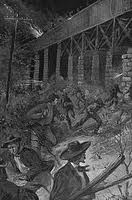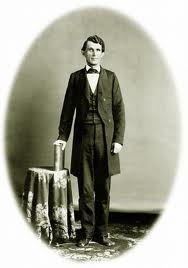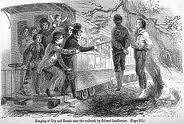 Tennessee Bridge-Burners, in 1861, were a group of Union Patriots and some paid the ultimate Sacrifice. The East Tennessee bridge-burning was a Civil War guerrilla warfare operation carried out by Union sympathizers in Confederate-occupied East Tennessee. The operation, planned by minister William B. Carter and was authorized by President Lincoln. The sabotage called for the destruction of nine railroad bridges and an invasion of East Tennessee by Union forces from Kentucky. While the conspirators managed to destroy five of the nine targeted bridges, the Federal Government didn’t follow through with the military occupation and many of the pro-Union conspirators were imprisoned, banished or hung.
Tennessee Bridge-Burners, in 1861, were a group of Union Patriots and some paid the ultimate Sacrifice. The East Tennessee bridge-burning was a Civil War guerrilla warfare operation carried out by Union sympathizers in Confederate-occupied East Tennessee. The operation, planned by minister William B. Carter and was authorized by President Lincoln. The sabotage called for the destruction of nine railroad bridges and an invasion of East Tennessee by Union forces from Kentucky. While the conspirators managed to destroy five of the nine targeted bridges, the Federal Government didn’t follow through with the military occupation and many of the pro-Union conspirators were imprisoned, banished or hung.
Militarily the East Tennessee campaigns were of no great significance in the Civil War. Politically, however, the area was important. This entire section of Tennessee, was predominately Union in its sympathies. The mountain and river valley area along the Upper Tennessee was a region of small farms. Slave owners were rare. Consequently in the state referendum in Tennessee, secession lost by some 20,000 votes-in the eastern counties.
East Tennesseans, Parson Brownlow and Andrew Johnson were quick to point out that in effect a free state was occupied by rebel forces. In the fall election the three mountain congressional districts elected Union men. These men maintained they were members-elect of the United States Congress, not of the Confederacy and they left for Washington to occupy their seats. Only one of the Congressmen succeeded in reaching the Capitol.
Washington was fully aware of the events in Tennessee. Lincoln knew that an invasion of a Union army would arouse the population and it would support the liberators. The President was eager to send an army to free the pro-Union residents of Tennessee.
 The bridge attacks were the brainchild of a longtime Carter County resident, the Reverend William Blount Carter, in conjunction with his brother, Union General Samuel P. Carter. Mr. Carter had traveled to Washington earlier in the year, where in a meeting at the White House, he secured Union political and military support. By October, he was recruiting Unionists, as far south as Bridgeport, Alabama and had developed several networks of saboteurs.
The bridge attacks were the brainchild of a longtime Carter County resident, the Reverend William Blount Carter, in conjunction with his brother, Union General Samuel P. Carter. Mr. Carter had traveled to Washington earlier in the year, where in a meeting at the White House, he secured Union political and military support. By October, he was recruiting Unionists, as far south as Bridgeport, Alabama and had developed several networks of saboteurs.
The conspiracy went awry almost immediately on the night of November 8, 1861. The Chickamauga Creek and Hiwassee bridges were poorly guarded, and were burned with minimal effort. The Bridgeport, Loudon, and Watauga bridges were heavily guarded by Confederate soldiers, and conspirators abandoned attempts to destroy them. The Lick Creek and Union bridges were guarded by one or two sentries each, who were easily overpowered before setting fire to the bridges. At the Strawberry Plains bridge, the crew encountered a lone Confederate guard and when an attempt was made to light a torch, the saboteurs were spotted and attacked. In the ensuing fiasco, two were badly wounded and the matches were lost. Unable to light a fire, the group abandoned the mission and fled for home.
Confederate Secretary of State Judah Benjamin sent Colonel Danville Ledbetter to identify, jail and hang as many participants in the bridge-burning scheme as he could find, and then rebuild the bridges. Benjamin instructions stated,
“I now proceed to give you the desired instruction in relation to the prisoners of war taken by you among the traitors of East Tennessee.
 First. All such as can be identified in having been engaged in bridge-burning are to be tried summarily by drum-head court-martial, and, if found guilty, executed on the spot by hanging. It would be well to leave their bodies hanging in the vicinity of the burned bridges.
First. All such as can be identified in having been engaged in bridge-burning are to be tried summarily by drum-head court-martial, and, if found guilty, executed on the spot by hanging. It would be well to leave their bodies hanging in the vicinity of the burned bridges.
Second. All such as have not been so engaged are to be treated as prisoners of war, and sent with an armed guard to Tuscaloosa, Alabama, there to be kept imprisoned at the depot selected by the Government for prisoners of war.”
Many of the prisoners were sent on a long, slow journey to the Confederate prison at Tuscaloosa, Alabama. Three conspirators were hung in Knoxville and two in Greeneville.
General Felix Zollicoffer, the commander of military affairs in East Tennessee declared martial law. The most outspoken Unionists in the region, including William “Parson” Brownlow, were forced to flee to Kentucky or other points farther North.
East Tennessee would remain under Confederate military control for nearly two years. Life in the region would remain tenuous for generations to come. Union and Confederate sympathies and memories of the conflict would haunt the residents, generating continuing violence between the mountain folk well into the 20th Century. The Tennessee Bridge-Burners attempted to disrupt the rebellion and the result was the ultimate Union Patriot Sacrifice.
Bummer


General Wm. H. Carroll Letter to J.P. Benjamin, Dec 11, 1861 talks about the conflict between Civil and Military Courts in trying these Cases. (p 759,760)
I would like to use it, but my copy won’t OCR and I’m a terrible Typist.
Would you have it in Text?
Thanks,
Monte Haun
Bulls Gap, TN
Monte;
Bummer will check for a digitized copy and if it can be located will email a copy.Thanks for
The read.
Bummer
I posted this piece on my facebook page and a friend told me we have a Bridge Burner plaque right off of Bonny Oaks drive area in Chattanooga. She never read it, but will now and then report it back to us. Will share it with you.
Thanks Sandy,
Bummer and wife are staying north of Sevierville from April 7th thru the 13th. Doing some background on kin and research on Civil War participants. Will attempt to post regularly while in Tennessee. Thanks for following and sharing Civil War Bummer.
“The old guy”